10 Best Offshore Fishing Techniques for New Anglers
As a new angler, you're stepping into an exciting world of offshore fishing, where mastering techniques like trolling, jigging, and drift fishing can greatly enhance your experience. Understanding the nuances of each method not only boosts your chances of a successful catch but also makes your time on the water more enjoyable. Ready to explore these essential techniques and discover how they can transform your fishing trips? Let's plunge into the details.
Understanding Trolling Techniques
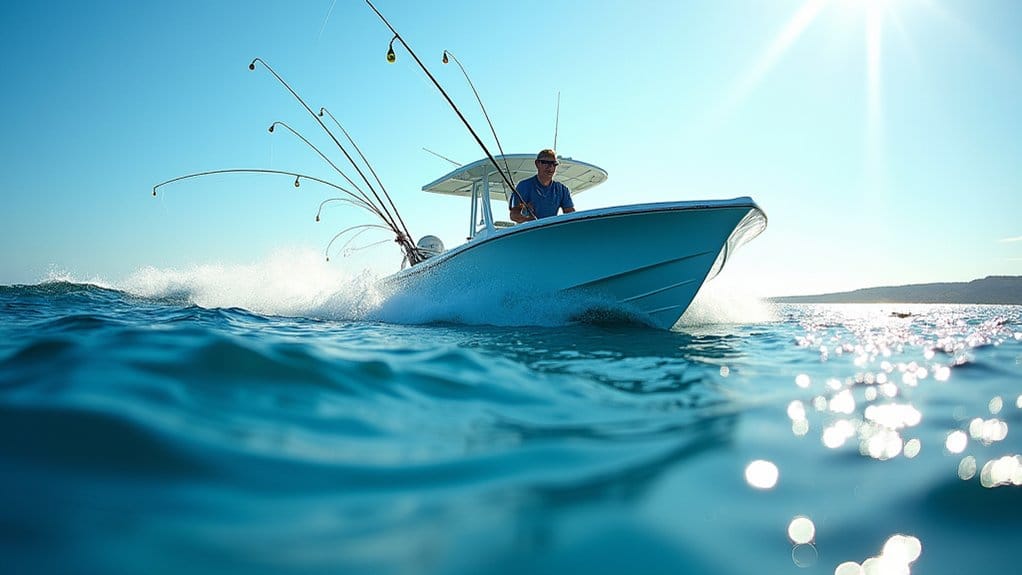
When you hit the open water for offshore fishing, understanding trolling techniques can greatly enhance your chances of landing a big catch. Trolling involves towing a lure or rigged bait behind your moving boat, which effectively attracts target fish like tuna, marlin, and mahi.
To maximize your success, maintain an ideal trolling speed between 5 to 9 knots, adjusting based on the species and lure type. Deploying multiple lines at varying depths using paravanes or downriggers helps cover more water.
Additionally, proper rigging methods, such as nose-rigging with circle hooks, improve hook-up rates and facilitate catch and release. Knowing your target fish's feeding patterns and preferred depths is essential, ensuring your fishing techniques are as effective as possible.
Mastering Jigging for Success
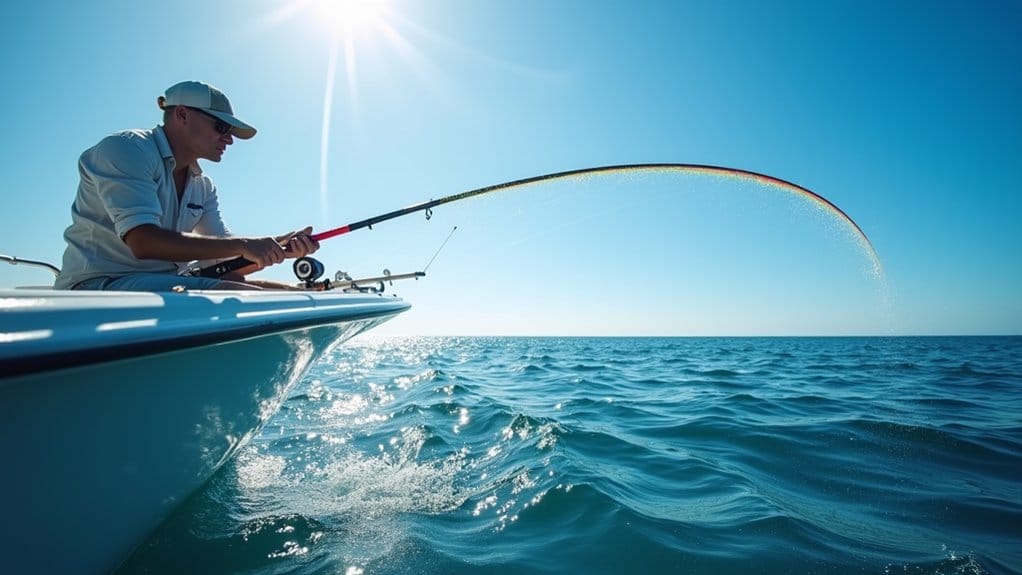
Trolling may get you out on the water, but mastering jigging can take your offshore fishing to the next level. This technique involves jerking a lure up and down to mimic the erratic movements of prey, effectively attracting fish like tuna and snapper.
To catch fish successfully, use specialized jigs, such as Hokkai lures or soft plastics, tailored to your target species and conditions. Pay attention to depth; adjust your jigging technique to match the fish's location.
As a beginner, practice maintaining a steady rhythm and speed, which enhances your chances of enticing a strike. Stay alert and ready to set the hook quickly after feeling a bite—fish can be swift, and you don't want to miss your chance!
Effective Drift Fishing Strategies
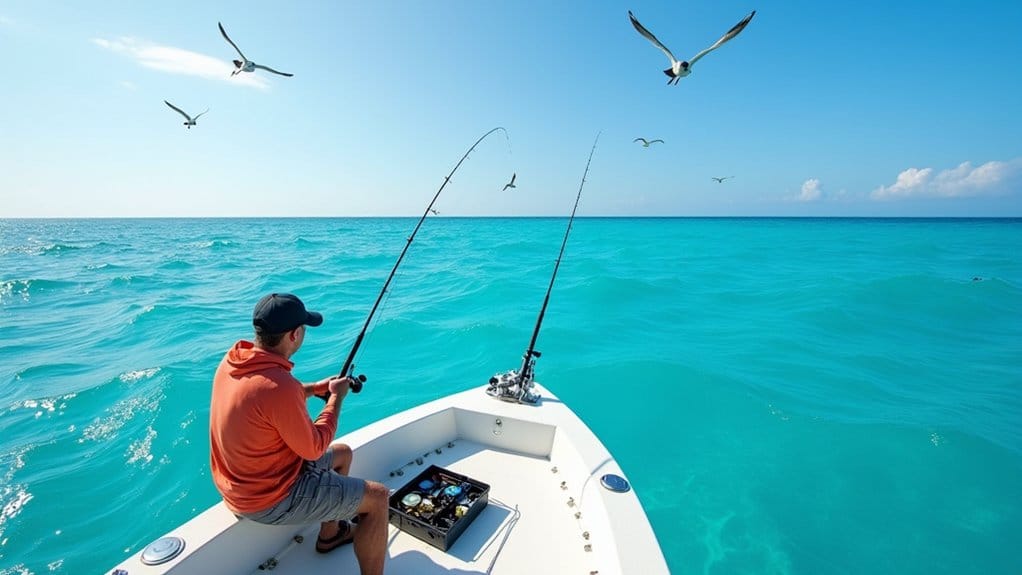
Drift fishing offers an exciting way to connect with fish by using the natural movement of the wind and currents to your advantage.
To succeed, start by understanding local conditions and the behavior of the species you're targeting. Using live bait while freelining can effectively attract bass and flounder, as the bait mimics natural movement in the water.
Choose the right tackle and lighter weights to guarantee a natural presentation, minimizing resistance. Consider employing a balloon float to maintain depth, especially when targeting larger species like shark or tuna.
Keep an eye on your drift speed and adjust your bait presentation accordingly; a natural motion increases your chances of getting a strike.
Happy fishing!
Anchoring for Bottom Fishing
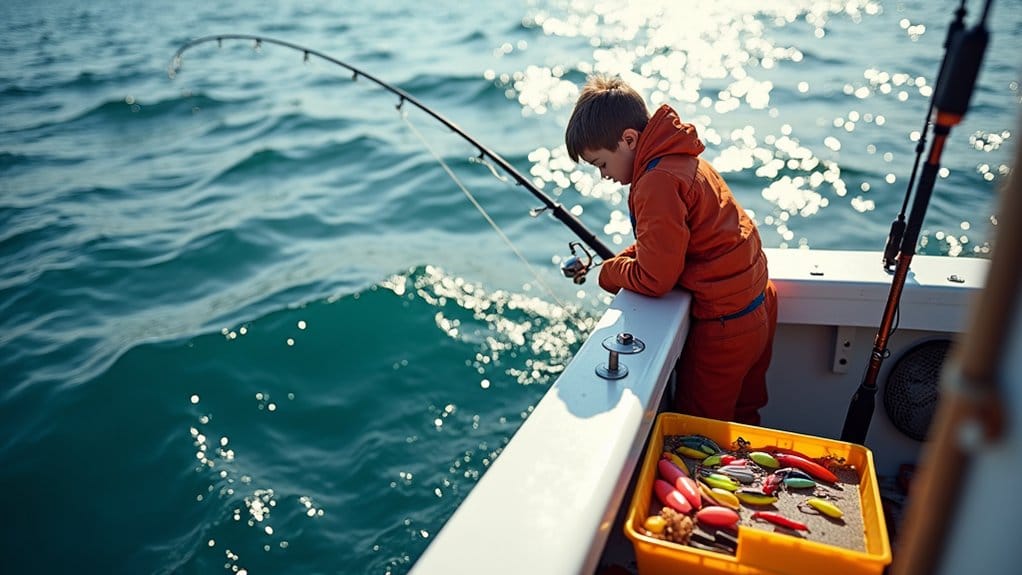
Effective anchoring is essential for successful bottom fishing, especially when targeting structures like reefs or wrecks.
First, position your boat directly over the target and make certain the anchor is set securely to avoid drifting. Use a strong anchor with a scope of 5:1 to 7:1 of rope to maintain stability against currents and wind.
To make it easier to return to productive spots, mark your anchoring position on your GPS. If the current is strong, consider employing a drift sock or sea anchor for added stability while bottom fishing.
Finally, always check local regulations regarding anchoring, as some areas have restrictions to protect sensitive marine habitats.
These fishing tips will help you anchor effectively and enhance your bottom fishing experience.
Utilizing Live and Artificial Baits
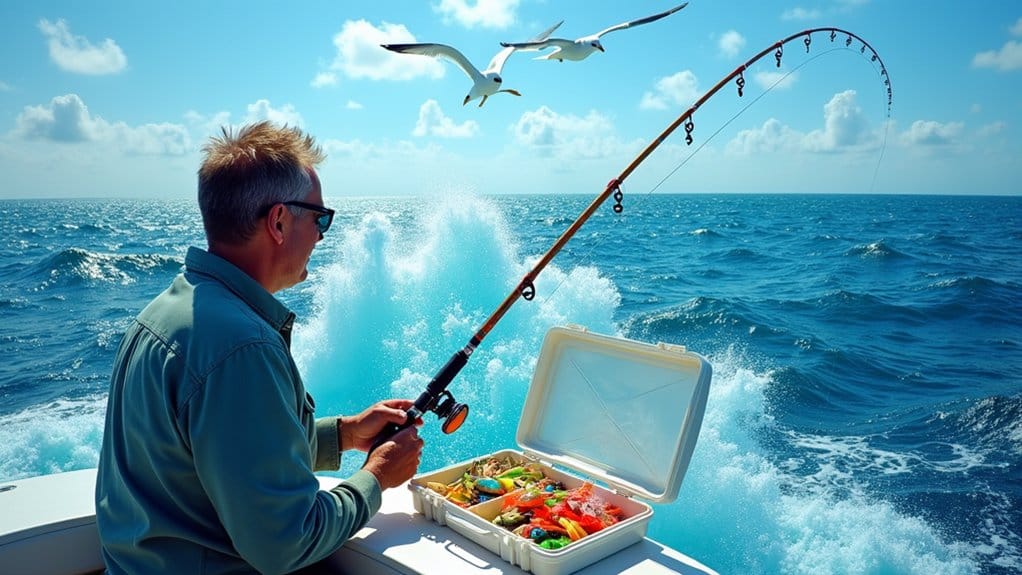
When you venture offshore, choosing the right bait can make all the difference in your fishing success. Live baits like ballyhoo, mullet, and squid are fantastic options for attracting tuna and billfish, thanks to their natural movement and scent.
When using live bait, be sure to employ proper rigging techniques, such as nose-rigging with circle hooks, to enhance your presentation.
On the other hand, artificial lures, including jigs and soft plastics, can effectively mimic prey, making them great for targeting mahi and wahoo. Don't hesitate to experiment with various colors, sizes, and actions of these lures.
Understanding the feeding habits of local fish species will help you choose the right live or artificial bait, improving your overall fishing techniques.
Reading Water Currents and Weather Patterns

To catch more fish offshore, understanding water currents and weather patterns is essential. Water currents greatly influence fish movement; you'll find that fish often gather near current edges where food is abundant. Target these areas for prime fishing spots.
Weather patterns also play a critical role. On overcast days, fish tend to be more active, while stable weather typically results in steady fishing. Pay close attention to tides, as fish are more active during moving tides, especially around structures like reefs.
Monitoring sea surface temperature is key, too; many species prefer temperatures between 70°F and 80°F. Finally, be aware of changes in barometric pressure; a drop can signal aggressive feeding before a storm, making it an opportune time to fish.
Communicating and Collaborating With Your Crew
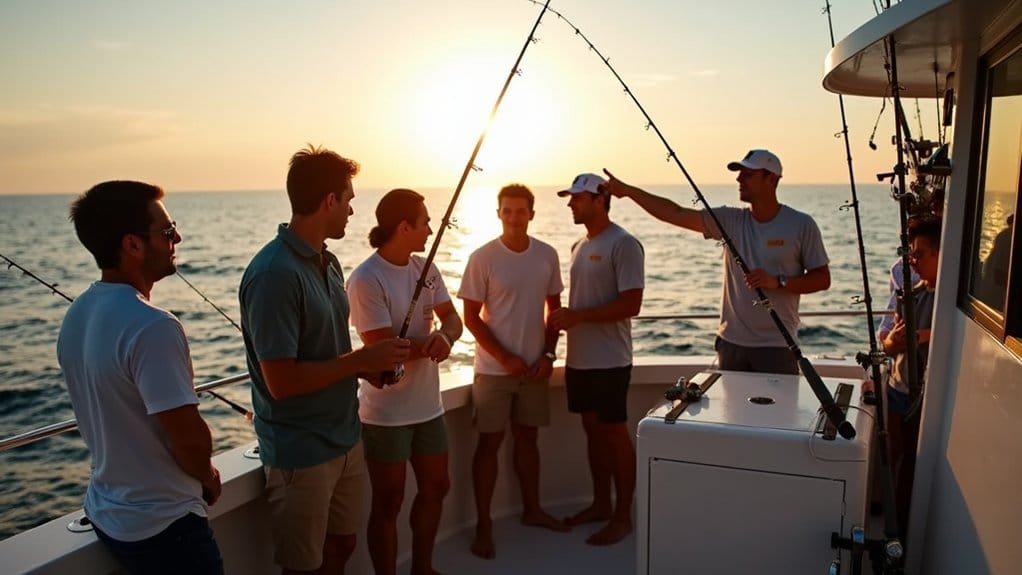
Strong communication and collaboration among your crew can greatly enhance your offshore fishing experience. Use clear, concise language to relay instructions and share observations about fish behavior.
Encourage everyone to voice their ideas and concerns, fostering a collaborative environment that improves decision-making and fishing outcomes. Establish defined roles, like designating a leader for specific tasks, to streamline operations and guarantee accountability.
In noisy environments, utilize hand signals and verbal cues to convey messages efficiently. Regularly check in with your crew, providing feedback and affirming their contributions.
This practice not only promotes a positive team dynamic but also enhances overall morale during your fishing trips. Remember, a well-connected crew makes for a successful day on the water.
Essential Gear and Equipment for Beginners
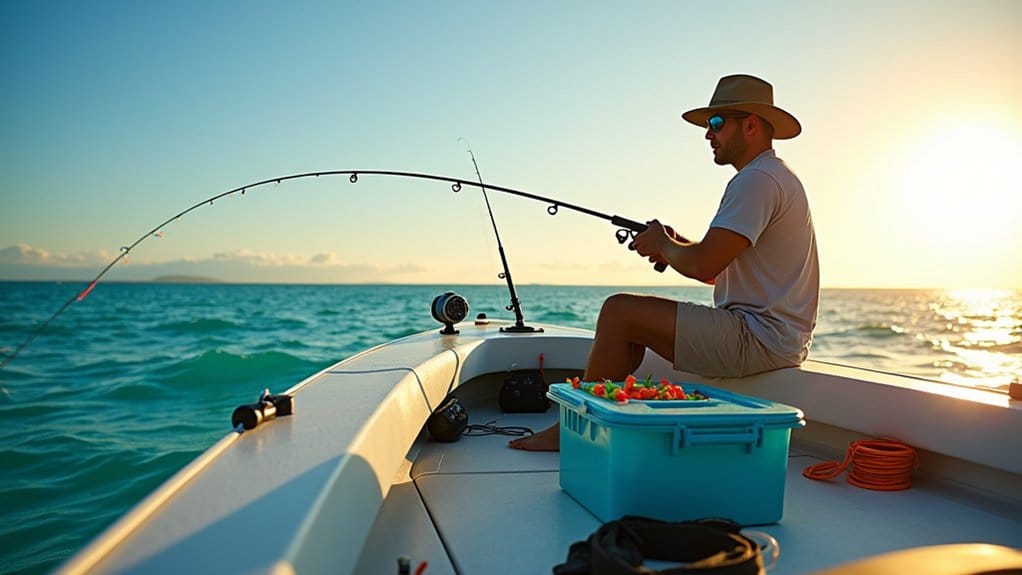
Getting started in offshore fishing requires the right gear and equipment to guarantee a successful and enjoyable experience.
You'll want to invest in a sturdy rod and reel combo rated for 30-50 lb test line, perfect for tackling larger species like tuna and mahi-mahi.
A selection of lures, including trolling lures and jigs in various shapes and colors, is essential gear to attract different fish.
Don't forget high-quality tackle, such as circle hooks and double sleeve copper crimps, which improve your catch rates.
Organizing your tackle box with rigged ballyhoo, artificial lures, and assorted hooks will streamline your fishing process.
These offshore fishing tips will help you maximize your time on the water and enhance your overall experience.
Safety Tips for Offshore Fishing
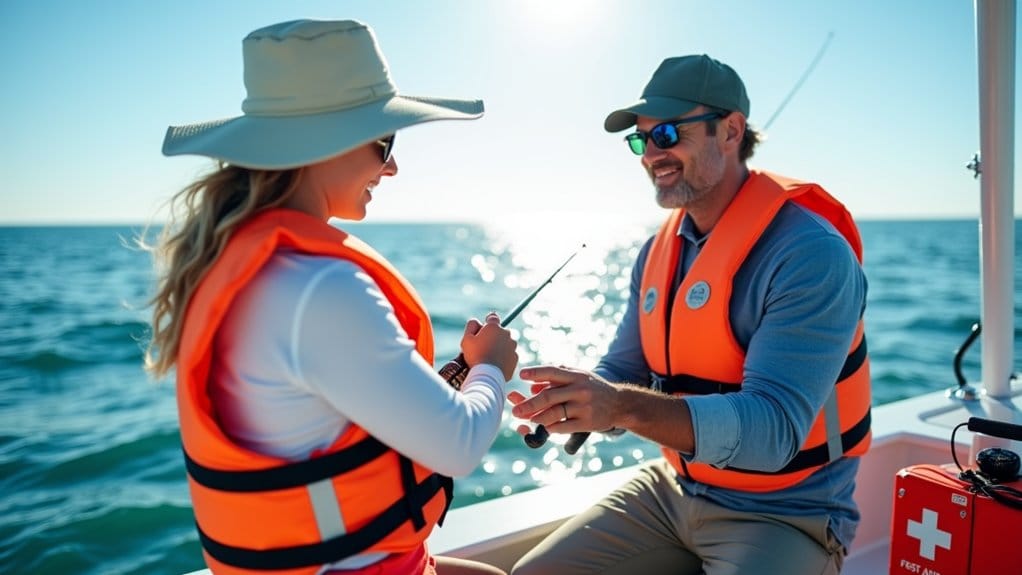
Once you've gathered the right gear and equipment for offshore fishing, it's equally important to prioritize safety while you're out on the water.
Always wear a life jacket and guarantee every crew member has access to personal flotation devices (PFDs). Familiarize yourself with the boat's safety equipment, including fire extinguishers and first aid kits, and regularly check their condition.
It's essential to monitor weather conditions closely before and during your trip; sudden changes can pose serious risks. Establish clear communication protocols with your crew using hand signals or radios, especially when handling fishing lines and equipment.
Finally, inform someone on land about your plans, including your intended location and expected return time, so help can be summoned if needed.
Learning From Experienced Anglers

Many new anglers find that learning from experienced fishermen can greatly enhance their skills and confidence on the water. Observing seasoned anglers during your fishing trips can reveal effective techniques, bait selection, and insights into species behavior that you won't find in traditional training.
Engage in conversations with experienced crew members to deepen your understanding of rigging, knot tying, and fishing etiquette. Participating in hands-on learning opportunities, like workshops led by knowledgeable captains, can fast-track your skill development.
Don't hesitate to ask questions during quieter moments; it encourages a proactive learning approach. Actively seeking mentorship from experienced anglers provides you with tailored advice and practical wisdom that can greatly improve your offshore fishing success.






